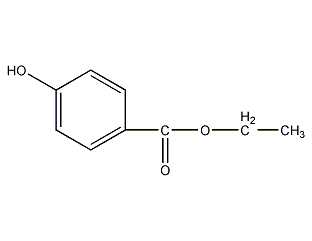
Structural formula
| Business number | 03C9 |
|---|---|
| Molecular formula | C9H10O3 |
| Molecular weight | 166.17 |
| label |
Ethyl paraben, Ethylparaben, Ethyl 4-Hydroxybenzoate, Ethylparaben, Nipagin A, preservative, Bacteriostatic agents; aromatic carboxylic acids and their derivatives |
Numbering system
CAS number:120-47-8
MDL number:MFCD00002353
EINECS number:204-399-4
RTECS number:DH2190000
BRN number:1101972
PubChem number:24847055
Physical property data
1. Properties: Colorless crystals or white crystalline powder, with a slight fragrance and a slightly astringent taste.
2. Relative density (25℃, 4℃): 1.078131
3. Relative vapor density (g/mL, air=1): Uncertain
4. Melting point (ºC): 116~118
5. Boiling point (ºC, 0.67kpa or 5 mmHg): 297.5
6. Refraction Rate: Uncertain
7. Flash point (ºC): Uncertain
8. Specific rotation (ºC): Uncertain
9. Autoignition point Or the ignition temperature (ºC) is uncertain
10. Vapor pressure (kPa, 25ºC): Uncertain
11. Saturated vapor pressure (kPa, 60ºC): Uncertain
p>
12. Heat of combustion (KJ/mol): Uncertain
13. Critical temperature (ºC): Uncertain
14. Critical pressure (KPa): Uncertain Determine
15. The logarithmic value of the oil-water (octanol/water) partition coefficient: Uncertain
16. The upper limit of explosion (%, V/V): Uncertain
17. Lower explosion limit (%, V/V): Uncertain
18. Solubility: Dissolved in water, solubility is 0.070% (20℃), 0.075% (25℃). Stable to light and heat, non-hygroscopic. Slightly soluble in water. Easily soluble in ethanol and propylene glycol.
Toxicological data
1. Acute toxicity: rat oral LD50: >200 mg/kg
Mouse oral LC50: 3mg/kg
Mouse peritoneal cavity LC50: 520mg/ kg
Dog oral LD50: 5 mg/kg
Guinea pig oral LD50: 2 mg/kg
Rabbit oral LD50: 5 mg/kg
2. Other multiple dose toxicity: Rat oral TDLo: 504mg/kg/12W-C;
3. Reproductive toxicity: Rat oral TDLo: 45600 mg/kg/8- 12D.
4. Mutagenicity: Escherichia coli: 10mmol/L;
Hamster fibroblasts: 250mg/L
Ecological data
None yet
Molecular structure data
1. Molar refractive index: 44.54
2. Molar volume (cm3/mol): 142.2
3. Isotonic specific volume (90.2K ): 366.9
4. Surface tension (dyne/cm): 44.2
5. Polarizability (10-24cm3): 17.65
Compute chemical data
1. Hydrophobic parameter calculation reference value (XlogP): 2.5
2. Number of hydrogen bond donors: 1
3. Number of hydrogen bond acceptors: 3
4. Number of rotatable chemical bonds: 3
5. Number of tautomers: 3
6. Topological molecular polar surface area (TPSA): 46.5
7. Number of heavy atoms: 12
8. Surface charge: 0
9. Complexity: 148
10. Number of isotope atoms : 0
11. Determine the number of atomic stereocenters: 0
12. Uncertain number of atomic stereocenters: 0
13. Determine the chemical bond configuration Number of centers: 0
14. Number of uncertain chemical bond stereocenters: 0
15. Number of covalent bond units: 1
Properties and stability
This product is a highly bactericidal substance with a phenol coefficient of 8.0. Very low toxicity and no irritation to human skin.
Storage method
1. Packed in iron drums lined with plastic bags. There are no special requirements for storage and transportation.
Synthesis method
1. It is esterified from p-hydroxybenzoic acid and ethanol and then refined.
![]()
2. Main Using esterification method. Parahydroxybenzoic acid is first produced by reacting potassium phenolate with carbon dioxide under pressure, and then performs an esterification reaction between parahydroxybenzoic acid and ethanol in the presence of a sulfuric acid catalyst, and finally undergoes washing, decolorization, recrystallization, centrifugal dehydration, and drying. have to.
Purpose
1. Parabens are one of the commonly used preservatives. It can inhibit the activity of respiratory enzymes and transfer enzymes of microbial cells, and destroy the cell membrane structure of microorganisms, thus having a wide range of antibacterial effects on molds, yeasts and bacteria. Its antibacterial ability is stronger than sorbic acid and benzoic acid, and its antibacterial effect is not greatly affected by the pH value. The effect is good within the pH value range of 4 to 8. Our country stipulates that for pastry fillings, the maximum dosage is 0.5g/kg (calculated as parahydroxybenzoic acid, the same below); in juice (leaf) beverages, jams (excluding cans), and soy sauce, the maximum dosage is 0.25g/kg; in The maximum dosage in carbonated drinks and egg yolk fillings is 0.2g/kg; the maximum dosage in vinegar is 0.1g/kg; the maximum dosage in fruit and vegetable preservation is 0.012g/kg.
2.Used as preservatives, bacteriostatic agents, cosmetics, and pharmaceuticals.
3. Used as an antioxidant in vegetable oils.

 微信扫一扫打赏
微信扫一扫打赏

